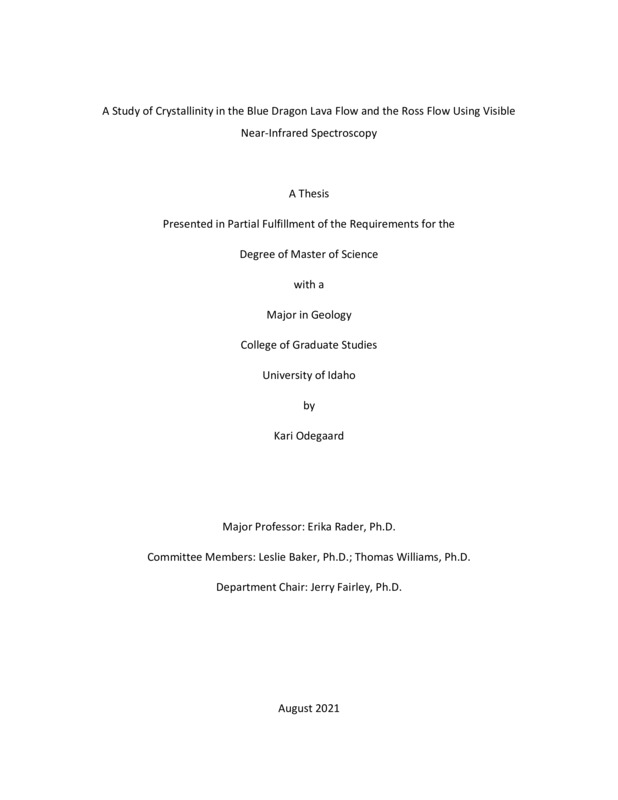A Study of Crystallinity in the Blue Dragon Lava Flow and the Ross Flow Using Visible Near-Infrared Spectroscopy
Odegaard, Kari. (2021-08). A Study of Crystallinity in the Blue Dragon Lava Flow and the Ross Flow Using Visible Near-Infrared Spectroscopy. Theses and Dissertations Collection, University of Idaho Library Digital Collections. https://www.lib.uidaho.edu/digital/etd/items/odegaard_idaho_0089n_12170.html
- Title:
- A Study of Crystallinity in the Blue Dragon Lava Flow and the Ross Flow Using Visible Near-Infrared Spectroscopy
- Author:
- Odegaard, Kari
- Date:
- 2021-08
- Keywords:
- Blue Dragon crystallinity Lava reflectance Ross Flow Visible Near-Infrared
- Program:
- Geology
- Subject Category:
- Geology
- Abstract:
-
Lava flows are volcanic hazards that have emplacement pathways and speeds that are difficult to predict. One variable that contributes to this unpredictability is the viscosity of the flow which changes by several orders of magnitude from eruption to solidification. To accurately estimate viscosity we must know the temperature, geochemistry, crystal content and vesicularity of the lava. While temperature and geochemistry can be quickly and safely assessed using a thermal camera and portable x-ray fluorescence spectrometer (XRF), crystal content and vesicularity require sample collection and microscopy. We propose that visible near-infrared spectroscopy (VNIR) can inform viscosity estimates with rapidly collected mineralogic data. Previous studies have used VNIR spectral features to distinguish mafic glass from olivine and plagioclase in basalt in laboratory settings. We test a handheld in-situ instrument protocol to estimate crystallinity on the Blue Dragon lava flow (BD) and the Ross Flow (RF), selected for their differing sizes, crystallinity, and vesicularity to determine the sensitivity of the instruments and any limitations. XRF was used to obtain bulk geochemistry. Samples were collected and the proportion of phases are identified from scanning electron microscope backscatter images. I hypothesize that prominence of VNIR absorbance features positively correlate with distance from the vent and increased crystallinity; RF will show decreased changes compared with BD due to size. The potential for improved modeling of lava flows for hazard management with remote VNIR rests on the instruments ability to detect typical ranges of crystallinity in natural lava. If successful, these spectrometers can be attached to high resolution satellites or drones for safe and distant data collection in real time
- Description:
- masters, M.S., Geology -- University of Idaho - College of Graduate Studies, 2021-08
- Major Professor:
- Rader, Erika
- Committee:
- Baker, Leslie; Williams, Thomas
- Defense Date:
- 2021-08
- Identifier:
- Odegaard_idaho_0089N_12170
- Type:
- Text
- Format Original:
- Format:
- application/pdf
- Rights:
- In Copyright - Educational Use Permitted. For more information, please contact University of Idaho Library Special Collections and Archives Department at libspec@uidaho.edu.
- Standardized Rights:
- http://rightsstatements.org/vocab/InC-EDU/1.0/

